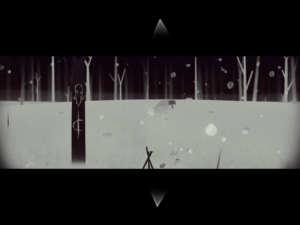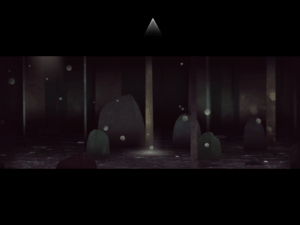For this assignment I played Year Walk, an eerie adventure game that was originally released in 2013 by the Swedish mobile game developer Simogo. Though originally released for iOS devices, it can also be played on Microsoft Windows and Wii U. Players who enjoy unique indie games will particularly enjoy Year Walk, a game that transforms the Swedish phenomena of year walking into an eerie first person adventure.
Year Walk tries to establish the narrative through down-up world-building techniques, attempting to immerse players by gradually unveiling the game’s universe through significant objects and clues. Year Walk could improve on the techniques that it relies on to guide the players through its narrative. When I played the game, I encountered many examples of frustrating significant objects that fail to help the player make progress in the game.
Year Walk players learn more about the world that they are in gradually in this embedded narrative. It is immediately clear that the game’s designers chose clever technical breakpoints that reduce the amount of effort required to create an immersive world, yet still provide an engaging experience to players. The game occupies only half of the device’s screen and relies on horizontal scrolling as the dominating procedure available to players. Year Walk demonstrates how a limited set of mechanics can effectively support an exploration-driven aesthetic. As an aspiring game designer, I admire how ‘Year Walk’ achieves robust world-building without the extensive resources required for larger scale games like ‘Fallout’ or ‘The Elder Scrolls’. The game’s world-building techniques successfully draw players into a hauntingly captivating environment, and create a desire within players to explore and understand more.
However, Year Walk players face many difficulties when they set out on their year walking journey, as they are met with significant objects that are too difficult to decipher. First, the navigation system, which relies on players scrolling horizontally and identifying and following up/down arrows on the screen, is particularly confusing. At various points, players are presented with multiple arrows, with only one leading to a story-relevant location. Therefore, players have to make multiple failed attempts to find the right location, without any guidance from the game. This repetitive process can cause cognitive overload among players who attempt to memorize all the different directions they can go, as well as frustration and boredom among players who do not want to memorize the entire map. Year Walk designers attempt to help players navigate their world by adding certain signs that hint to players about the right direction (Figure 2). However, these signs are not intuitive and leave the player feeling even more confused.

Figure 2: Signs on the left tree are meant
to help find the right direction
When players finally stumble upon the significant objects that can help them solve the mystery, they find objects that are difficult to interpret as well. While I found many such examples throughout the game, I think the best example is this segment of the game (Figure 3) where players find themselves scrolling vertically in an environment where all the signals look exactly the same, except for the different sounds coming out of different locations. In this segment, players are supposed to compare the tone coming out of each location to the background to see if the melody is the same. This intended solution – matching environmental sounds to a character’s singing – requires a musical discernment that the game had not previously demanded or indicated was necessary. This sudden shift in required skills can feel jarring and frustrating, as there was no clear indication that such abilities would be needed. This lack of guidance on how to progress, combined with the recurring difficulty in interpreting significant objects, significantly impedes the player’s ability to effectively navigate and engage with the story (Figure 3, 4).
“In ‘Year Walk,’ players engage in a recurring loop that involves exploring the environment, identifying significant objects, and solving puzzles. However, players often face a challenge in transitioning from discovering objects to solving the associated puzzles, which can result in cognitive overload or boredom. Despite the game’s success in crafting a deeply mysterious and engaging world, it would benefit from a clearer integration of significant objects that more effectively guide players through the narrative, thus enhancing the overall gameplay loop.





